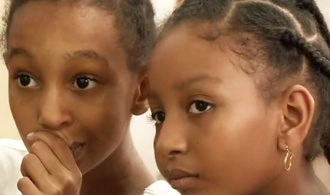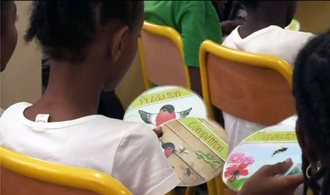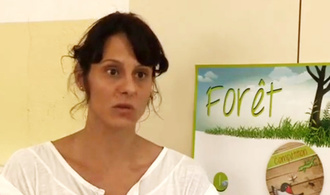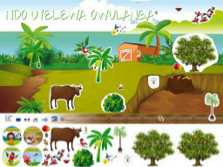In my garden there are...
Written by Modified on the
... Flying foxes, lizards, lemurs?! From predators to competitors, through cooperation and parasitism, this biodiversity awareness workshop, developed by the CIRAD, Sciences Réunion and the University of Reunion Island, allows children on the islands of Reunion and Comoros to better understand their environment and identify key relationships between living things.
The project, launched in 2011 and known as "In my garden, there are ..." is an agro-ecology and biodiversity-themed educational tool designed for school children from eight to twelve years old.
Through this workshop, children learn about the environment, including the role and place of living creatures in their natural environment. Using this knowledge, they will become more aware of the importance of balance in an ecosystem such as a garden, teeming with life and inter-species relationships.
Adapting the program for the Comoros
This project is organized as part of the broader ePRPV program and teaches regional and global environmental issues. Where degradation of the natural environment from farming threatens the ecosystem, education and knowledge of the environment raises awareness which, with time, helps curb these threats.
After being tested on the Island of Reunion, the program was introduced to the Comoros. Despite their proximity, these islands have their own distinct fauna, flora and culture. It was therefore necessary to adapt the program to the Comoros. In 2013, 12 science teachers were trained in the program at the French school in Moroni, explains Sébastien Boyer, scientific facilitator at Sciences Réunion:
"First, teachers are trained in scientific activities so that they understand the context of the program. Then, there’s training in ecology and agro-ecology. Finally, the program is adapted and translated into Shikomori and teachers give a classroom presentation in front of pupils from the French school of Moroni."
Now called "Ndo uyelewa owulanga" for the Comoros, the program was then presented to pupils from different villages. Virginie Bannier, scientific facilitator at Sciences Réunion, led several of these workshops. She shared her experience with us:
Bio&Agri - How does the program work?
Virginie Bannier – The tool is in three parts: firstly, a magnetic board and magnets is used to introduce animals and insects living in the garden and to consider the consequences. For example, we show a bird and a butterfly and ask: "What is the relationship between these two animals?" At that point, children have to raise small signs to express themselves, either on predation, cooperation, parasitism or competition. These four terms are defined at the outset.
Afterwards, we mix up the animals and insects. For example, the bird will eat the butterfly. "But I love butterflies and I want them to stay in my garden, what should I do?": I get rid of the insectivores. But this will have a negative impact on the garden. The insects will breed out of control and will need to feed. And what will they eat? The plants I grow in my garden, so perhaps it was not such a good idea after all.
Next, we reverse things: we add large quantities of insectivores. This time, the birds feed on insects, until there are no longer any left, they have nothing to eat, and the lack of pollinators means there are no more fruit in my garden.
In the second part, other environments are presented: the ocean, the forest and the urban surroundings. Through puzzles, pupils working in teams must identify which animals come from which environment and identify any relationships between them.
If there is time left at the end, they give a presentation, either in the form of a role play, or just a short sentence to present relationships.
B&A – Why the Comoros ?
VB - It was a specific request from CIRAD. They wanted a link between the Comoros and Reunion Island. There was already someone there working on the ePRPV project [Editor's note: Christiane Grimault]. Poor agricultural practices in the Comoros including mono-cultures, slash and burn cultures causing deforestation, combined with the lack of land, prompted this request. The idea was to tailor an educational program to the islands and educate the children there. The University of Comoros was asked to translate the names of certain animals and help suggest animals representative of the various environments of the Comoros.
B&A - What were the challenges you encountered?
VB - The main difficulties were that teachers there were unable to use the program in its original form. They have large classes (40-50 pupils) while in Reunion we generally work with two groups of 15. They have time constraints, and are afraid of not being able to finish the curriculum. They have a considerably shorter teaching week: only four half days with a curriculum similar to France’s. Finally, we had to choose which Shikomori dialect to use: each island has its own dialect. Then, there is the problem of monitoring: it is hard for us to get feedback on the program as CIRAD does not have a permanent presence on the islands.
This program was used in 2013 and 2014 in more than 40 classes and helped teach ecology to nearly 700 students in Reunion Island and the Comoros. This regional partnership between Reunion and the Comoros was the focus of a report by Serge Marizy:
More info: www.sciences-reunion.net/Dans-mon-jardin






